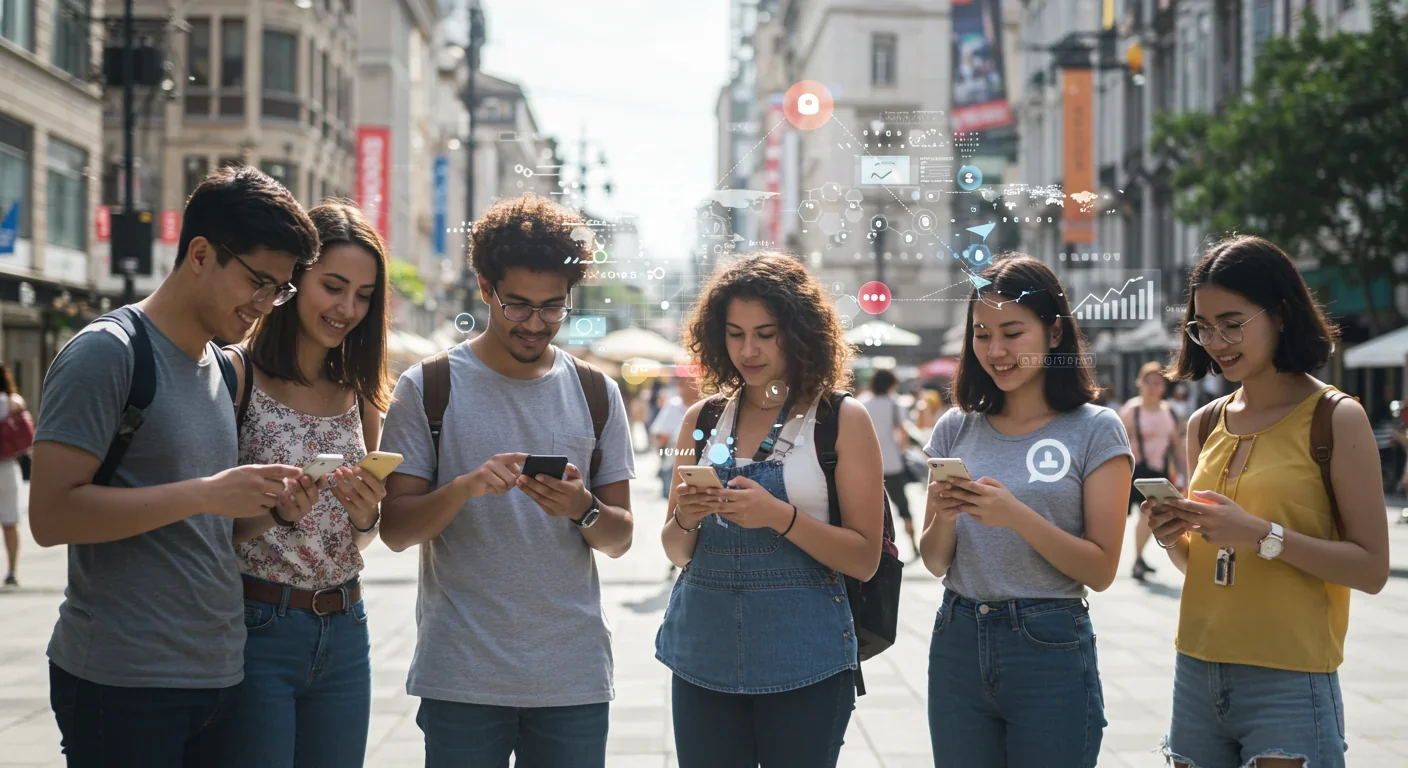Why Your Brain Is Hardwired to Lose Money

TL;DR: Culture now evolves thousands of times faster than genetics, as ideas spread through social networks and digital platforms in days rather than millennia. This acceleration transforms everything from business innovation to personal identity, making cultural adaptability the key survival skill.

A TikTok dance can reach 100 million people in three days. A genetic mutation might take 100,000 years to spread through the same population. That difference isn't just dramatic, it's a fundamental truth about how humans evolve now. Culture has become the dominant force shaping our species, and recent research confirms it's accelerating far beyond what our DNA can keep up with.
While genes plod along at their ancient pace, requiring generations to propagate beneficial traits, ideas sprint through populations at light speed. This isn't metaphor. The mechanisms driving cultural evolution operate on entirely different timescales than biological evolution, and understanding this gap reveals why humans conquered the planet without being the strongest, fastest, or smartest animals around.
Genetic evolution works through mutation, selection, and inheritance across generations. A beneficial gene might increase from 1% to 50% of a population over thousands of years. That's rapid by evolutionary standards, yet glacial compared to cultural change.
Cultural evolution moves differently. According to dual inheritance theory, humans inherit information through two channels: genes and culture. While genetic transmission happens vertically (parent to child), cultural transmission flows vertically, horizontally (peer to peer), and obliquely (from any older individual to any younger one).
This multi-directional flow creates exponential spread. When agriculture emerged around 10,000 years ago, farming techniques dispersed across continents in mere centuries. The Neolithic Revolution transformed human civilization faster than any genetic adaptation possibly could.
Consider the numbers. Human genetic mutation rates sit around 10^-8 per base pair per generation. Even beneficial mutations face a long road to fixation, assuming they aren't lost to genetic drift first. Meanwhile, a single person can learn a new skill, teach it to dozens of others, who each teach dozens more. The math isn't even close.
Recent models show conformity bias amplifies cultural transmission. When people preferentially adopt behaviors they see frequently, ideas reach saturation points exponentially faster than random transmission would predict. Social media has supercharged this effect, but the underlying mechanism is ancient.
Social learning gives humans an unfair advantage. While other species must learn primarily through trial and error, humans excel at observational learning. Albert Bandura's research demonstrated that people acquire complex behaviors just by watching others, without direct reinforcement.
This ability scales. Cultural evolution theory identifies several transmission mechanisms: teaching, imitation, and language. Each method carries different fidelity and speed characteristics. Teaching preserves information accurately but requires time investment. Imitation spreads faster but introduces variation. Language enables abstract concept transmission at unprecedented speed.
Network effects magnify everything. When a platform, idea, or technology becomes more valuable as more people use it, positive feedback loops accelerate adoption. The telephone wasn't useful until enough people had one. Facebook hit critical mass when your friends joined. These aren't just business phenomena, they're fundamental properties of cultural transmission.
Technology compounds the acceleration. Writing preserved knowledge across generations without degradation. Printing multiplied distribution. The internet eliminated geographic constraints entirely. Each innovation reduced the friction in cultural transmission, increasing speed and reach.
TikTok represents the current extreme. The platform's algorithm creates what researchers call "context collapse", where content instantly reaches diverse audiences worldwide. A trend can emerge in Jakarta, hit Berlin by lunchtime, and dominate New York by dinner. Analysis shows TikTok trends spread 3-5x faster than on other platforms, thanks to algorithmic amplification and seamless remix features.
But speed isn't the only advantage. Cultural evolution enables horizontal gene transfer's equivalent, borrowing successful adaptations across unrelated lineages. Japanese manufacturing techniques transformed American auto production in decades. Korean beauty standards influenced global cosmetics in years. Ideas jump between cultures far more easily than genes jump between species.

Charles Darwin observed finch beaks adapting to different food sources across the Galápagos Islands, a process spanning thousands of generations. Modern researchers observe cultural evolution in real-time.
Joseph Henrich's work shows how cumulative cultural evolution separates humans from other primates. We don't just learn, we improve incrementally across generations, a process called the ratchet effect. A child learns what adults know, then adds their own innovations, which the next generation builds upon. This cumulative process created everything from language to spacecraft.
Consider the humble plow. Early versions appeared around 3,000 BCE. Each generation modified the design, adding wheels, adjustable blades, iron reinforcement. By medieval times, plows were sophisticated machines embodying centuries of accumulated innovations. No single inventor understood every improvement, each built on inherited knowledge.
Internet memes demonstrate the same process compressed into weeks. A photo becomes a template. Users add variations. The format evolves, spawning sub-genres and mutations. Some variations die, others thrive and reproduce. The entire lifecycle of mutation, selection, and inheritance plays out in days rather than millennia.
Richard Dawkins coined "meme" in 1976 to describe cultural replicators analogous to genes. The concept proved prescient. Memetics studies ideas as living things competing for brain space and transmission opportunities. Successful memes share traits: they're memorable, emotionally resonant, and easy to communicate.
Digital platforms created near-perfect conditions for memetic evolution. Low barriers to creation, instant global distribution, and metrics showing real-time fitness (likes, shares, views) accelerate selection pressures. An idea can be born, tested, and either amplified to millions or discarded, all before lunch.
Companies increasingly recognize cultural evolution as competitive advantage. Organizational culture determines how quickly firms adopt innovations, respond to markets, and evolve capabilities.
Silicon Valley's dense network effects exemplify cultural evolution's business impact. Engineers move between companies, carrying practices and knowledge. A breakthrough at Google propagates through the ecosystem as employees spread to startups and competitors. This horizontal transmission accelerates innovation far beyond what individual firms could achieve in isolation.
Open source software represents cultural evolution in pure form. Linux, Python, and countless other projects evolve through distributed contribution. Thousands of developers add features, fix bugs, and propose improvements. Successful additions get adopted widely, unsuccessful ones fade. The code base evolves through variation and selection, curated by community consensus rather than genetic inheritance.
Fashion cycles demonstrate cultural evolution's commercial power. Trends emerge, spread through social networks, reach saturation, and die, replaced by reactions against them. The cycle accelerates constantly. What took decades in the 1950s now completes in months. Fast fashion companies like Zara built empires by optimizing their cultural transmission speed, moving designs from runway to store in weeks.
Marketing now treats ideas as organisms to be bred and released. Viral campaigns aren't lucky accidents, they're engineered using principles of memetic fitness. Emotional resonance, shareability, and network targeting replace traditional advertising's broadcast approach. The ideas that survive and reproduce do so because they're adapted to their information ecosystem.
Individual identity formation now occurs in an environment of unprecedented cultural flux. Previous generations inherited relatively stable cultural contexts. Your parents' values, community norms, and available life paths changed slowly across their lifetimes.
That stability has evaporated. A teenager today encounters more diverse cultural influences before graduating high school than their grandparents experienced in a lifetime. Social media exposes young people to global subcultures, niche communities, and conflicting value systems simultaneously.
This creates both freedom and anxiety. You can construct identity from a buffet of cultural options rather than inheriting a fixed template. But the options multiply faster than anyone can evaluate them, and social proof mechanisms pressure conformity to whatever's trending.
Language evolution illustrates the personal stakes. New slang emerges constantly, spreading through digital networks. Generational divides form in years rather than decades. Parents struggle to decode their children's communication, not because of age gaps but because cultural transmission now outpaces generational turnover.
Professional identity faces similar pressures. Skills become obsolete rapidly as best practices evolve. A programming language dominates, then fades, in five years. Career paths that seemed stable vanish as industries reorganize around new cultural and technological realities. Continuous learning isn't optional, it's survival.
Yet humans possess remarkable cultural adaptability. We're built for social learning. The same mechanisms that enable rapid cultural evolution also let individuals ride the waves of change. People who cultivate learning networks, expose themselves to diverse influences, and practice cultural flexibility thrive in this environment.

Educational systems designed for slower cultural evolution struggle with current acceleration. Traditional schooling assumes stable knowledge and skills that remain relevant for decades. That assumption fails when cultural and technological landscapes shift continuously.
Modern educational theory emphasizes meta-skills: learning how to learn, critical thinking, adaptability. These capabilities enable individuals to participate in cultural evolution rather than being overwhelmed by it. Teaching specific facts matters less than developing the capacity to acquire, evaluate, and apply new information rapidly.
Policy faces parallel challenges. Regulations assume relatively stable conditions, but cultural evolution undermines those assumptions. By the time lawmakers understand and respond to a technological or social shift, the landscape has transformed again. This mismatch between cultural evolution speed and institutional response time creates governance crises.
Effective policy in this environment requires different approaches. Rather than prescriptive rules that quickly become obsolete, flexible frameworks that adapt to evolving cultural contexts work better. Regulatory sandboxes, iterative policy development, and participatory governance align better with rapid cultural change.
Public health campaigns demonstrate what works. Instead of static messages, successful campaigns use cultural transmission mechanisms intentionally. They identify influential nodes in social networks, create shareable content, and design messages that people want to spread. The idea becomes the intervention, evolving as it propagates through communities.
Different societies navigate cultural evolution at different speeds and through different values. This creates both opportunities and tensions.
Some cultures prize rapid adoption of innovations, others value stability and tradition. Neither approach is universally superior. Speed enables quick responses to challenges but risks losing valuable cultural knowledge. Stability preserves hard-won wisdom but may prevent necessary adaptations.
Agricultural history shows how cultural evolution created diverse solutions to similar problems. Societies worldwide independently developed farming, but the specific techniques, crops, and social organizations varied enormously. This diversity represents parallel cultural evolution experiments, each adapted to local conditions.
Modern globalization creates unprecedented cultural mixing. Ideas that evolved in specific contexts spread globally, often with unexpected results. Western individualism meets Eastern collectivism. Digital natives' norms collide with traditional hierarchies. These encounters generate both creative syntheses and cultural conflicts.
Some fear cultural homogenization as Western, particularly American, culture propagates globally through media and technology. Others see diversification as niche subcultures thrive online. Both trends occur simultaneously. Mainstream global culture consolidates around certain platforms and practices while countless micro-cultures flourish in digital spaces.
China's approach to cultural evolution differs markedly from the West's. Government plays active curator roles, promoting certain cultural elements while restricting others. This directed cultural evolution contrasts with the more chaotic, distributed evolution in open societies. Which approach proves more adaptive remains an open question.
Understanding cultural evolution's acceleration provides practical advantages. First, recognize you're not trying to learn everything, you're developing selection criteria for what ideas to adopt and which to ignore. Curating your cultural inputs matters enormously.
Second, invest in learning networks. Your ability to access, evaluate, and apply new ideas depends on connections to diverse knowledge sources. Strong networks function as cultural early warning systems, alerting you to important shifts before they become obvious.
Third, develop cultural literacy across multiple domains. The more fluent you are in different cultural contexts, the better you can navigate between them and identify valuable ideas from unfamiliar sources. Specialists often miss innovations from adjacent fields; generalists with broad cultural competence spot connections.
Fourth, practice deliberate cultural experimentation. Try new tools, explore unfamiliar communities, test different practices. Some experiments will fail, that's expected. But systematic exploration yields valuable discoveries that pure conformity never finds.
Finally, balance speed and stability. While cultural evolution accelerates, not every trend deserves adoption. Maintain core values and practices while selectively upgrading around the edges. This "explore-exploit" strategy, common in evolutionary systems, optimizes between innovation and reliability.
Cultural evolution's speed continues increasing. Each new communication technology, from writing to social media, accelerated transmission. What comes next?
Artificial intelligence introduces unprecedented dynamics. AI systems now generate ideas, art, and innovations at superhuman speed. When cultural evolution's pace exceeds human cognitive processing, we enter uncharted territory. The ideas that dominate may be those optimized for machine sharing rather than human understanding.
Augmented reality and brain-computer interfaces promise even faster cultural transmission. Imagine downloading skills, experiences, or knowledge directly. The distinction between learning and installing blurs. Cultural evolution could accelerate beyond recognition.
Yet humans remain remarkably adaptable. Our capacity for cultural evolution enabled our species' success. The same flexibility that let us transition from hunter-gatherers to farmers to industrial workers to knowledge professionals continues serving us. We're built for this.
The future belongs to individuals, organizations, and societies that understand and harness cultural evolution. Those who cultivate learning, embrace change, and participate actively in cultural creation will thrive. Those who resist or fail to adapt will struggle.
Your genes gave you remarkable capabilities, but it's the ideas you carry, share, and create that determine your impact. In a world where culture evolves faster than biology, the memes you spread matter more than the genes you inherited. Choose them wisely.

MOND proposes gravity changes at low accelerations, explaining galaxy rotation without dark matter. While it predicts thousands of galaxies correctly, it struggles with clusters and cosmology, keeping the dark matter debate alive.

Ultrafine pollution particles smaller than 100 nanometers can bypass the blood-brain barrier through the olfactory nerve and bloodstream, depositing in brain tissue where they trigger neuroinflammation linked to dementia and neurological disorders, yet remain completely unregulated by current air quality standards.

CAES stores excess renewable energy by compressing air in underground caverns, then releases it through turbines during peak demand. New advanced adiabatic systems achieve 70%+ efficiency, making this decades-old technology suddenly competitive for long-duration grid storage.

Our brains are hardwired to see patterns in randomness, causing the gambler's fallacy—the mistaken belief that past random events influence future probabilities. This cognitive bias costs people millions in casinos, investments, and daily decisions.

Forests operate as synchronized living systems with molecular clocks that coordinate metabolism from individual cells to entire ecosystems, creating rhythmic patterns that affect global carbon cycles and climate feedback loops.

Generation Z is the first cohort to come of age amid a polycrisis - interconnected global failures spanning climate, economy, democracy, and health. This cascading reality is fundamentally reshaping how young people think, plan their lives, and organize for change.

Zero-trust security eliminates implicit network trust by requiring continuous verification of every access request. Organizations are rapidly adopting this architecture to address cloud computing, remote work, and sophisticated threats that rendered perimeter defenses obsolete.